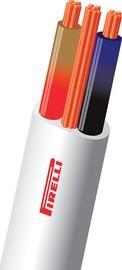Following on from last mont’s letters, Keith Elves looks at the new British Standard on cables
BS 7346-6:2005 is the new standard defining the performance requirements of various types of fire-rated cables in maintaining circuit integrity for life safety, fire-fighting and property protection systems under fire conditions. It describes two classes of cable (see Table 1):
- Life safety systems: systems that must remain operational to alert, evacuate and protect occupants
- Fire-fighting systems: active systems for protecting and assisting fire-fighters.
Fire survival timescales for life safety systems are different according to whether evacuation is a single stage or phased (Table 1).
BS 7346-6:2005 introduces new test methods to assess cable performance in a fire, in direct mechanical impact and in firefighting water shock: all conditions associated with a real fire incident. It requires all elements of the test to be applied to a single cable sample.
Table 2 provides performance recommendations for fire-rated cable circuits in buildings. It calls for the fire resistance of fixings, management systems, joints and terminations to at least match the survivability of the cable. Some fire-rated cables offer full mechanical protection and can be fixed directly to the building structure. For cable systems requiring additional mechanical protection, care must be taken to ensure these do not compromise the cable in a fire.
By introducing a more accurate replication of fire dynamics into cable test methodology, BS 7346-6 offers fire safety engineers a meaningful guide to the capability of different fire performance cables in respect of their application.
Source
Building Sustainable Design
Postscript
BS 7346-6 is available now from BSI at www.bsi-global.com
Keith Elves is senior manager of Westminster District Surveyors Service. The content of this article is not an official view of the City of Westminster






















No comments yet